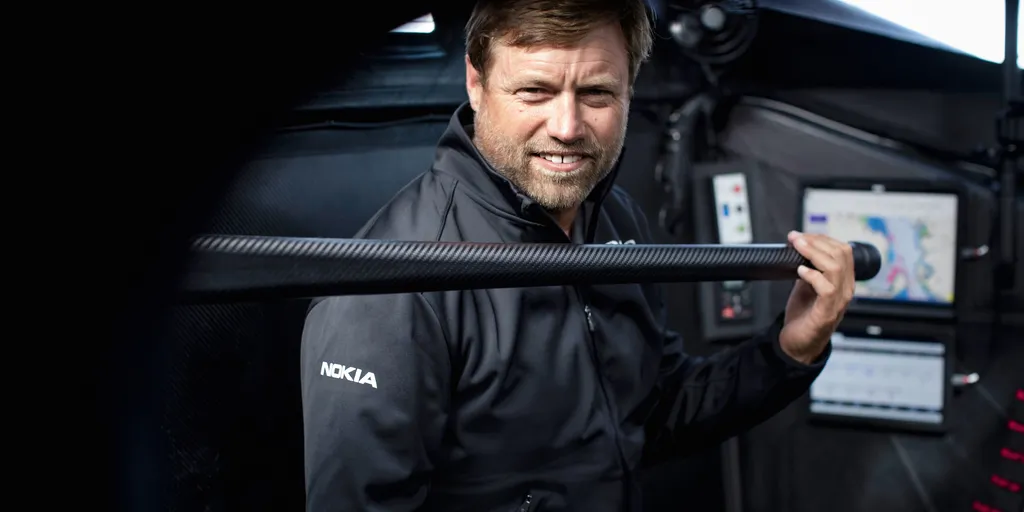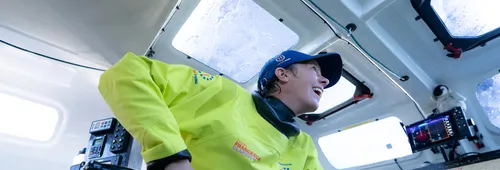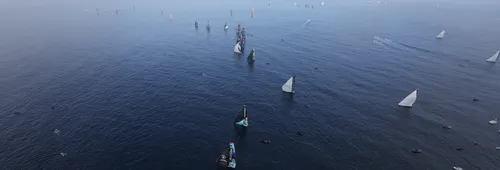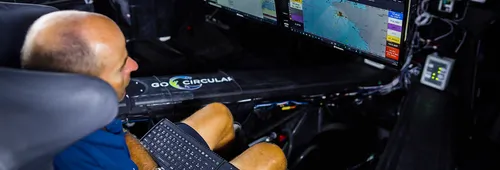Alex you have been following a pretty rigorous, careful routine to protect yourself and your team, how have things changed and do you have a set routine for these final few days?
There is nothing much changed for me to be honest. We had a month’s holiday in Jersey when we could but otherwise we have been following the same strict protocols. We could just never afford to lose any time if myself or any other members of the team got infected, so there is no real change for me at all.
What’s your target with regards to sleep between now and the start, do you try to get into a sleep routine?
Right now into the start I just make sure I bank as much as I can. I don’t want to have a sleep debt at the start. I am just being sensible, eating healthy, eating well and enjoy the little bits when I can. But also we are still working hard, we are working right up until 1302hrs on Sunday when the race starts. We have got until that time to continue developing, understanding and building the knowledge. On this boat we have 350 sensors and we have gigabytes of data. We have fibre optics in the hull and the foils. We measure some of this data at 100hz (100 times a second) and we are still learning until we start.
So much more now you are just processing data, more than sailing intuitively, looking always at performance targets, sail shapes, rig loads, foil deformation rather than looking up the rig and trimming to what you see?
It is a mix of both. The data is a tool to help your understand it. We have grown up feeling it in the seat of our pants, the human brain is an amazing computer. We measure the accelerations and slamming. We started this year with a slamming limit at 1.8 to 2G and then with addition of the fibre optics in the hull we have dropped that down to 1.6g. We log the acceleration at 1hz but we set the alarm at maximum peak. But here is an example. A month ago we were going upwind quite fast and we were getting 1.3G 1.5G 1.6G and then suddenly out of the blue came a 2.5g slam. And I was sitting in front of the computer and I felt it and the alarm came up and went off. It was a massive slam and Neal was in the bunk and bunk snapped and he fell out of it. But interestingly at 1hz on the log it is not there. So, it shows you that humans can still feel things at a much higher rate. So that is the thing. Here if and when you feel something you can go into the data and see ‘is that real?’ ‘is that true?’ and that allows you to calibrate and know more about it. It is definitely a mix of intuitive feel and data> And I think that is true in Formula 1. Someone like Lewis Hamilton is very good at being able to feed back what he is feeling and the engineers can look at the data and confirm the path to go forwards.
Physically and mentally then this boat is harder and more stressful to sail than the previous one. You have data going through your head all the time and so find it harder to switch off, or does it help relieve the stress and tension?
I find it fascinating. In some ways this boat is much easier. You have got more information, literally 350 pieces of information being spat out. And for me that makes it easier. The way the boat is set up with the cockpit I am basically sleeping very comfortably right there.
Everybody, including other skippers, want to know if it becomes claustrophobic sailing inside your cockpit?
I don’t find it claustrophobic. People used to say that after the last race. I joked that I lived in a cave, I had a huge cover at the back of the last boat and a cloth that came down which I called the Wendy House and so I could not really see out but it was a lot less comfortable. It is what you get used to. It has certainly not been a problem for us.
You are now sailing multihull angles and speeds, the differences in terms of angles and speeds sailed on this race course by the latest generation foilers will be bigger, what are the key things you are looking for in terms of conditions and preferred angles?
One of the big changes is for these boats to go at multihull speeds very close to the wind. That is a big change. The limitation are the hulls, that was not maybe expected as much and the slamming areas are much further back now. I think there are limitations there. But our real area is downwind, the race is a downwind race. I hear people talking about it being a reaching race, but for me if you look at the stats, the two southern ocean legs the angles are mostly wider than 100 deg TWA and actually close to 50% VMG downwind. That exclusion zone now, if you say there is no loss in a gybe, your routing would have you doing 1000 gybes between Africa and Australia. That has been our focus, making the boat go fast downwind. The only difference can be the Equator north, that can be 25-30 per cent upwind. But we look at our simulations and we look at weather from 1979 onwards and it does not matter how slow the boat goes upwind, as long as you are go faster downwind then that is the way to go. That has been our big learning from the beginning. That was the learning we used on the last boat and we have pushed it even further this time.
But on these boats it is the apparent wind angles you sail which are more key, what is a typical AWA downwind for example?
In flat water upwind we go upwind at 28 AWA and downwind at 50AWA, so we are a multihull., but of course on the ocean you are significantly slowed by waves. And then that difference can be huge.
But in perfect, golden opportunities like at the leading edge of a depression you can gain huge miles?
I guess where lots of records are broken as you enter the Southern Ocean ahead of a front on flat water and go extremely fast. Nobody goes out to do that, to break records, but the 2012 race was special for that with Francois taking the record then (Thomson took it back in January 2017 at 536.81nms). I have held the record for 11 of the last 17 years.
What’s the objective over the first week of the race. How do you pace yourself?
My objective is to just get into the rhythm and the sleeping programme, staying well hydrated and eating well and just find the rhythm, trying not to end up with a big problem. As the speeds get higher then reliability becomes more important. Downtime costs you more miles. And so reliability has been a massive focus for us over this last year.
It seems like on most of the big races you have always been prepared to, or indeed happy to take your own option – for example on the last Route du Rhum – do you feel more inclined to stay with the pack more in the early stages of this race?
The big unknown is what the different performances are between the different boats. On the last boat we were slower inside 90 TWA on the last boat we were faster wider than 120 TWA and especially VMG. We have not lined up since the Transat Jacques Vabre when we saw the boat was extremely rapid downwind. If the performances are different when you run the route then the routes will be different. What I can’t say is I am going to go with everybody else and not sail my optimum route. I am not afraid to go my own way. You write your programme, your plan to develop your boat. You decide how many foils you are going to develop, how different will they be, how much sailing are you going to do, how much focus you will put on reliability. And so you have your boat which conforms to a set of numbers and you got to trust them. You have to be conscious of where the others are, sure you do, but you can’t change your whole plan to stay with them. Otherwise you are just throwing away the advantages you have worked for.
In terms of the technologies you have developed where do you see your biggest single gain?
All of them! We have made some massive improvements on downwind sails with Doyle Sails. The structured luff technology is unbeatable today. But the biggest gain is autopilots. We are running our own machine learning on the boat. What we identified is that the human body can sense what is coming next when we are driving or steering a boat. Call that anticipation. We anticipate. And until now a pilot could not anticipate, brining machine learning on to the boat we can predict a few seconds ahead with eight or nine different variables to augment the computer. It anticipates. Before we were working with Nokia Bell Labs before the last race, sailing VMG downwind in 20kts of wind was a stressful experience, you would get the least amount of sleep, there would be broaches and so on. This time that will be when I will sleep the most.
And has it been hard for you to not be in Les Sables d’Olonne connected to the boat and to your team in the build up?
It is not a great scenario to be in. I have got a tremendous amount of sympathy for the organisers. It is a tough, tough time. I am just happy the race is happening. Ok we are taking a loss on the sponsors aren’t able to come, my family cant come, there are lots of losses along the way, but ultimately this sport always has been consumed on the internet. And the way I feel about it this is a wonderful opportunity to have people at home with internet access. Our sport has an opportunity to entertain. This can be game changing now, not just in France. To me most important is internationally and so fingers crossed, I intend to do as much entertaining and informing as possible.



